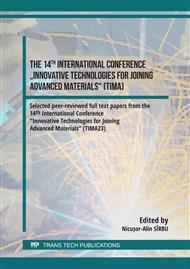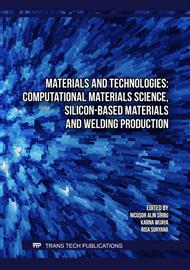p.3
p.11
p.21
p.27
p.37
p.45
p.51
p.59
p.75
Ultrasonic Welding Parameter Optimization for Electric Component Welding
Abstract:
Industrial requirements to establish metallic joints between dissimilar metals in the electric area. The ultrasonic welding process is an optimal process to joint thin sheets or foils. The goal of the research was to optimize the ultrasonic welding parameters to join thin nickel-coated copper sheets and aluminium sheets. It used a 0.5 mm thick high-purity copper (Cu-OF-R200) sheet coated with a 10 μm pure nickel layer and a 0.5 mm thick aluminium (1050A H24) sheet. The ultrasonic welding is made by a Branson Ultraweld L20 ultrasonic welder equipment. The mechanical properties and exacting geometrical tolerance of the joint were required. The welding parameter optimization is made empirically, with several welding tests. The optimal welding parameters were confirmed by non-destructive and destructive tests of the joints. The non-destructive tests were the visual inspection and geometrical measurements of the joint sizes. The destructive tests were tensile tests and macroscopic and microscopic tests. The completed test results confirmed the process applicability and the quality of the joint.
Info:
Periodical:
Pages:
37-42
Citation:
Online since:
October 2024
Authors:
Keywords:
Price:
Сopyright:
© 2024 Trans Tech Publications Ltd. All Rights Reserved
Share:
Citation:



